Table of Contents
- Introduction
- Editor’s Choice
- Cakes Market Overview and Statistics
- Consumer Preferences For Selecting Cakes Statistics
- Popular Ingredients and Flavors For Cakes Statistics
- Demographics of Cakes Consumers Statistics
- Recent Cakes Consumer Trends Statistics
- Health Concerns Associated With Cakes Consumption Statistics
- Recent Developments
- Conclusion
- FAQs
Introduction
Cakes Statistics: The cake industry is a significant part of the broader bakery market, offering various cake products, from classic sponge cakes to specialty and artisanal options.
Consumer preferences heavily influence the demand for cakes, with a rising interest in healthier alternatives and customization.
Key players in the industry range from large commercial bakeries with established brands to smaller regional and local businesses.
Challenges include health concerns regarding sugar and calories, intense competition, and supply chain disruptions.
However, opportunities exist to embrace natural product trends, diversify offerings, and explore online sales channels.
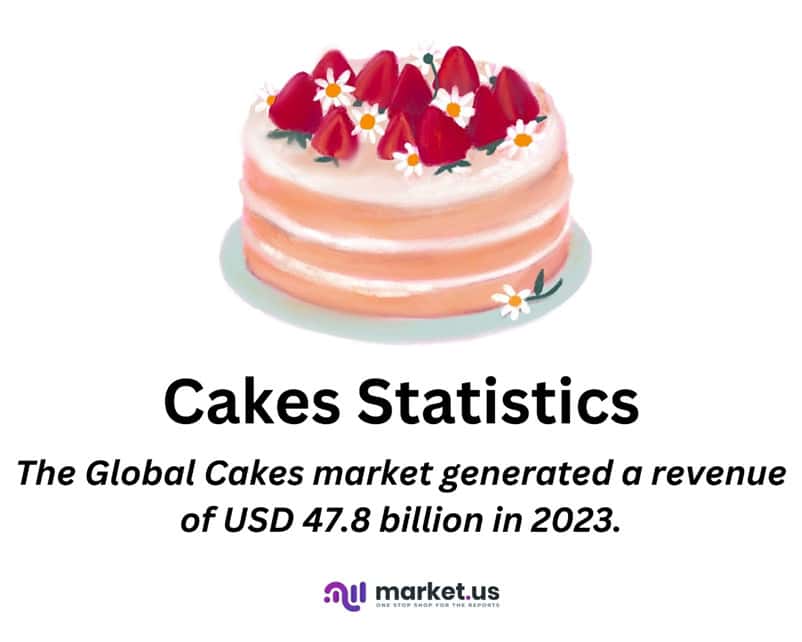
Editor’s Choice
- The global cake market generated a revenue of USD 47.8 billion in 2023.
- In North America, it holds a significant share of 28.8%, highlighting the popularity of cakes in this region.
- MCKEE Foods emerges as the leading player in the cakes market, commanding a substantial 19% market share.
- Remarkably, a substantial 77% of consumers prioritize taste as the foremost consideration when selecting cakes, cake bars, or sweet baked goods, with price ranking as the second most influential factor.
- Among age groups, individuals aged 20 to 30 constitute the largest segment, accounting for a significant 44.9% of cake consumers.
- Among cake enthusiasts, females dominate the consumer base, representing a majority share of 58.5%.
- Recent survey findings revealed that cake was a common presence in the office. With 86% of respondents reporting its availability at least “once or twice a week.”
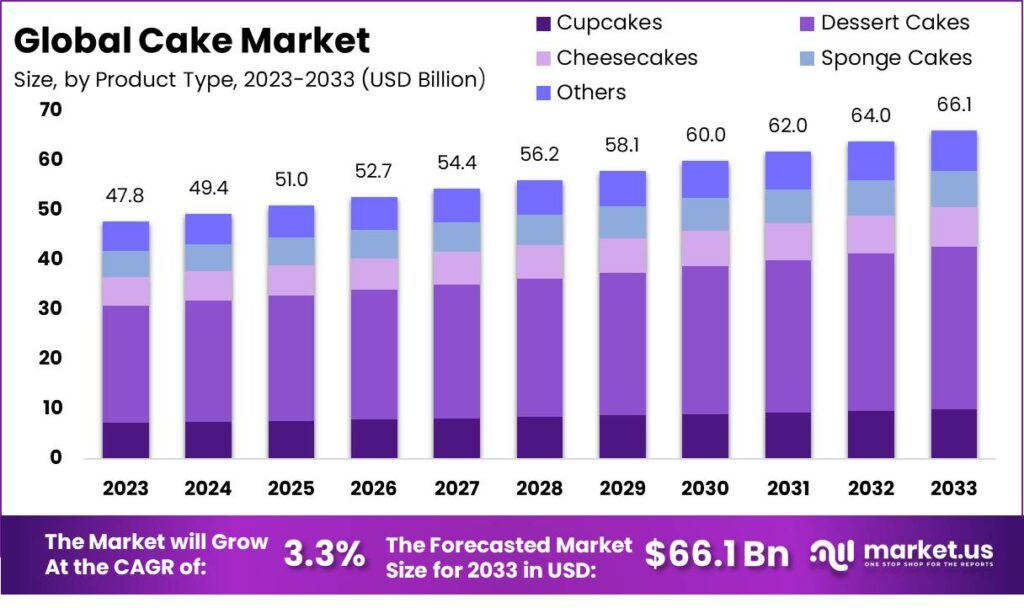
Cakes Market Overview and Statistics
Global Cakes Market Size Statistics
- The cakes market is showing a promising trend of consistent growth over the forecasted years at a CAGR of 3.3%.
- Starting at USD 47.8 billion in 2023, the market’s revenue is expected to steadily increase year by year. By 2024, it is projected to reach USD 49.4 billion, followed by USD 51.0 billion in 2025.
- This upward trajectory continues with revenue figures of USD 52.7 billion in 2026. USD 54.4 billion in 2027, and USD 56.2 billion in 2028.
- The market is anticipated to maintain its growth momentum, surpassing USD 60.0 billion by 2030, and reaching USD 66.1 billion by 2033.
- This consistent rise in market revenue can be attributed to factors such as evolving consumer tastes, and product innovation. The expanding presence of cakes across various occasions and demographics makes it an attractive industry for potential investors and businesses alike.
(Source: Market.us)
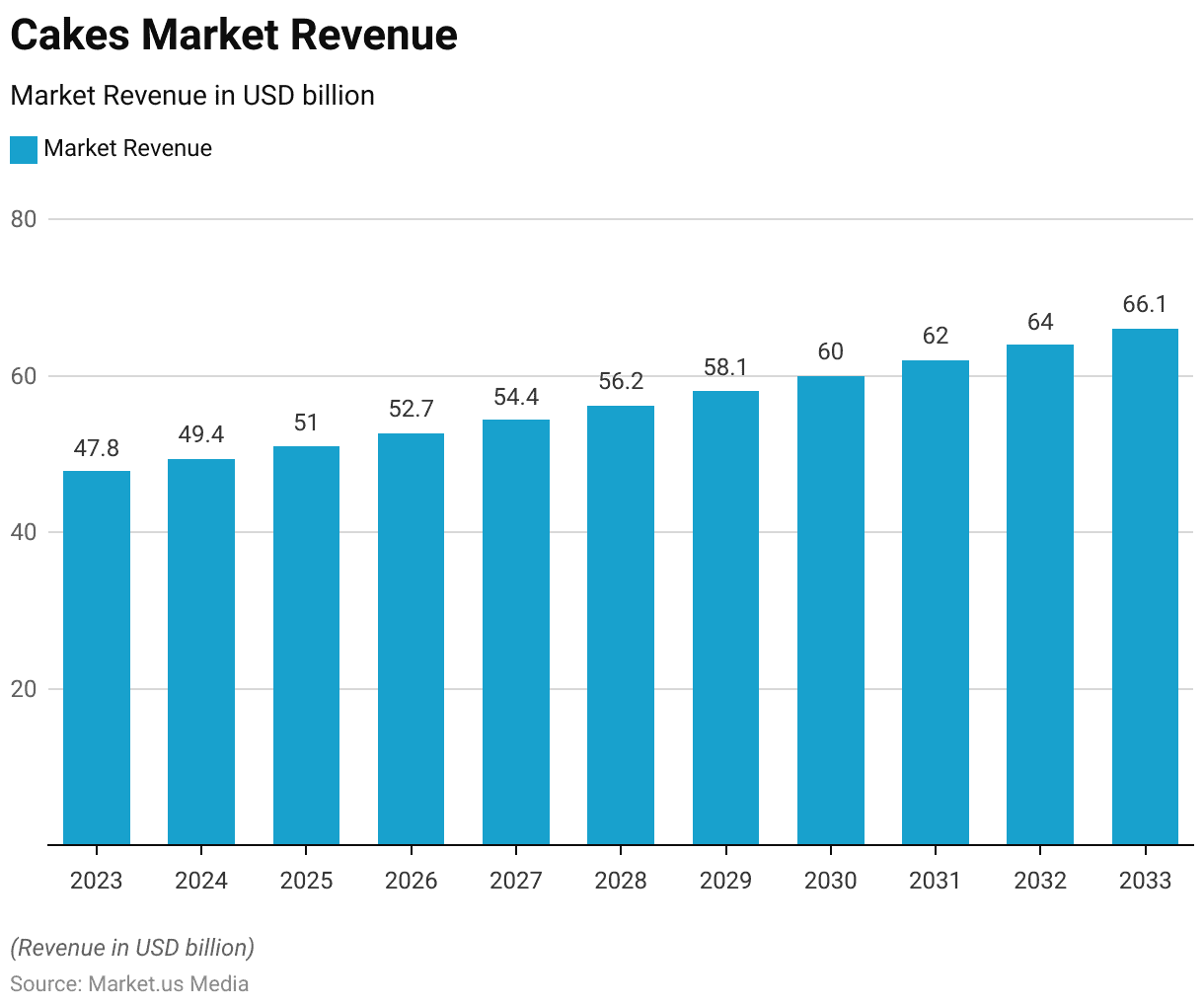
Regional Analysis of the Global Cakes Market Statistics
- The cake market exhibits a global presence with varying regional market shares.
- In North America, it holds a significant share of 28.8%, highlighting the popularity of cakes in this region.
- Europe closely follows with a substantial market share of 31.3%, reflecting strong demand for cakes across European countries.
- The Asia-Pacific (APAC) region contributes significantly as well, accounting for 28.6% of the market. Indicating a growing consumer base for cakes in this diverse and populous region.
- South America and the Middle East & Africa (MEA) regions hold smaller but notable market shares of 7.0% and 4.3%. Respectively, demonstrating the global reach of the cake industry.
- These regional variations in market shares emphasize the need for tailored strategies and approaches to cater to diverse preferences and consumer behaviors across different parts of the world.
(Source: Market.us)
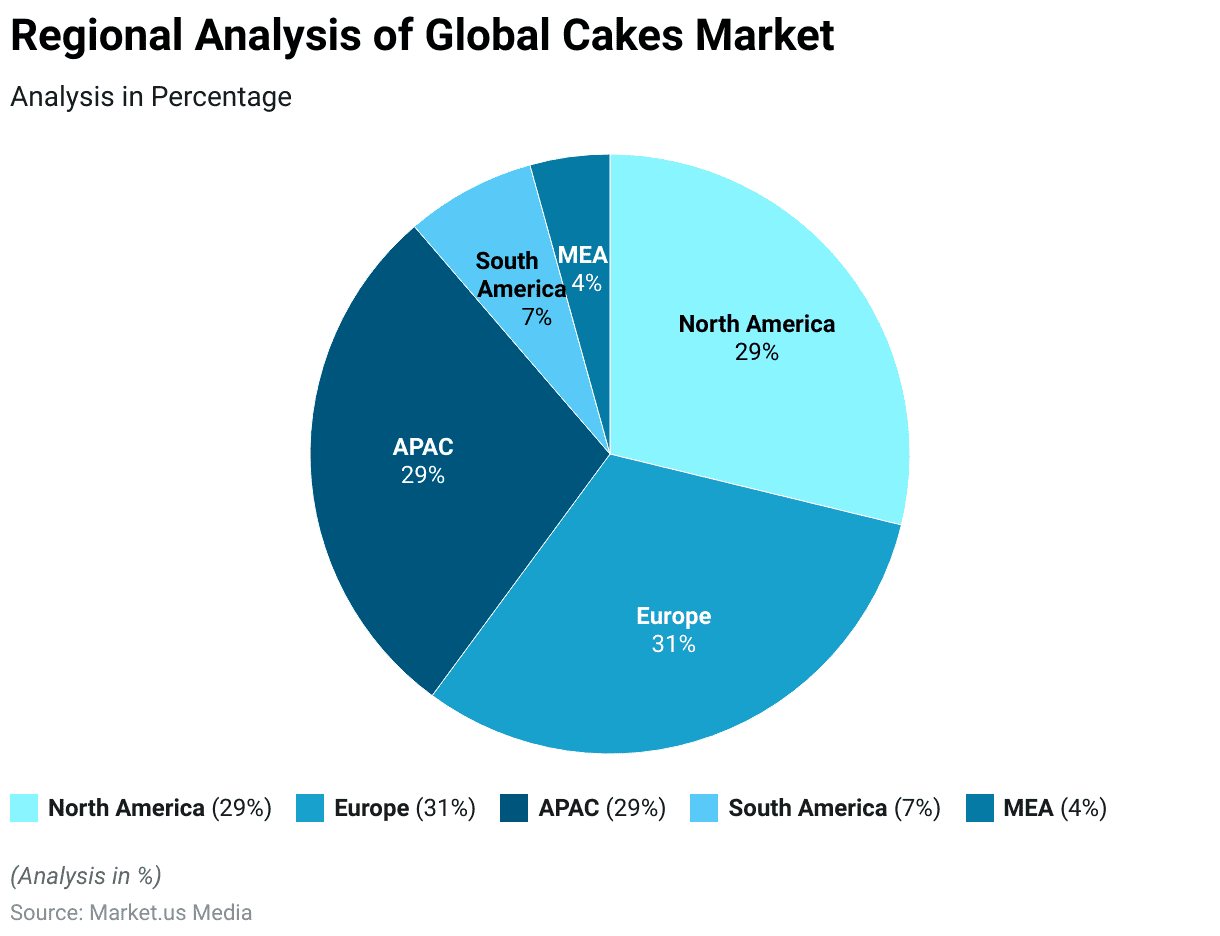
Key Players in the Global Cakes Market Statistics
- MCKEE Foods emerges as the leading player in the cakes market, commanding a substantial 19% market share. This company’s strong market presence signifies its ability to resonate with consumers and deliver products that meet their preferences and expectations.
- Finsbury Food Group Plc secures the second-largest market share at 17%. This indicates a significant market presence and competitive positioning within the cake industry.
- Yamazaki Baking Co., Ltd holds a noteworthy 13% market share. This suggests a strong presence, possibly driven by product innovation and quality.
- BreadTalk Group Limited captures 10% of the market share, signifying its prominence in the cake industry.
- Grupo Bimbo and Hostess Brands, LLC both share an 8% market share, indicating their equal footing within the industry.
- George Weston Limited secures a 7% market share, showcasing its relevance in the cakes market.
- Monginis holds a 6% market share, demonstrating its competitiveness in the cake industry.
- The collective contribution of other key players accounts for 8% of the market share. These players, although individually smaller, play a significant role in the industry’s overall competitiveness, innovation, and diversity.
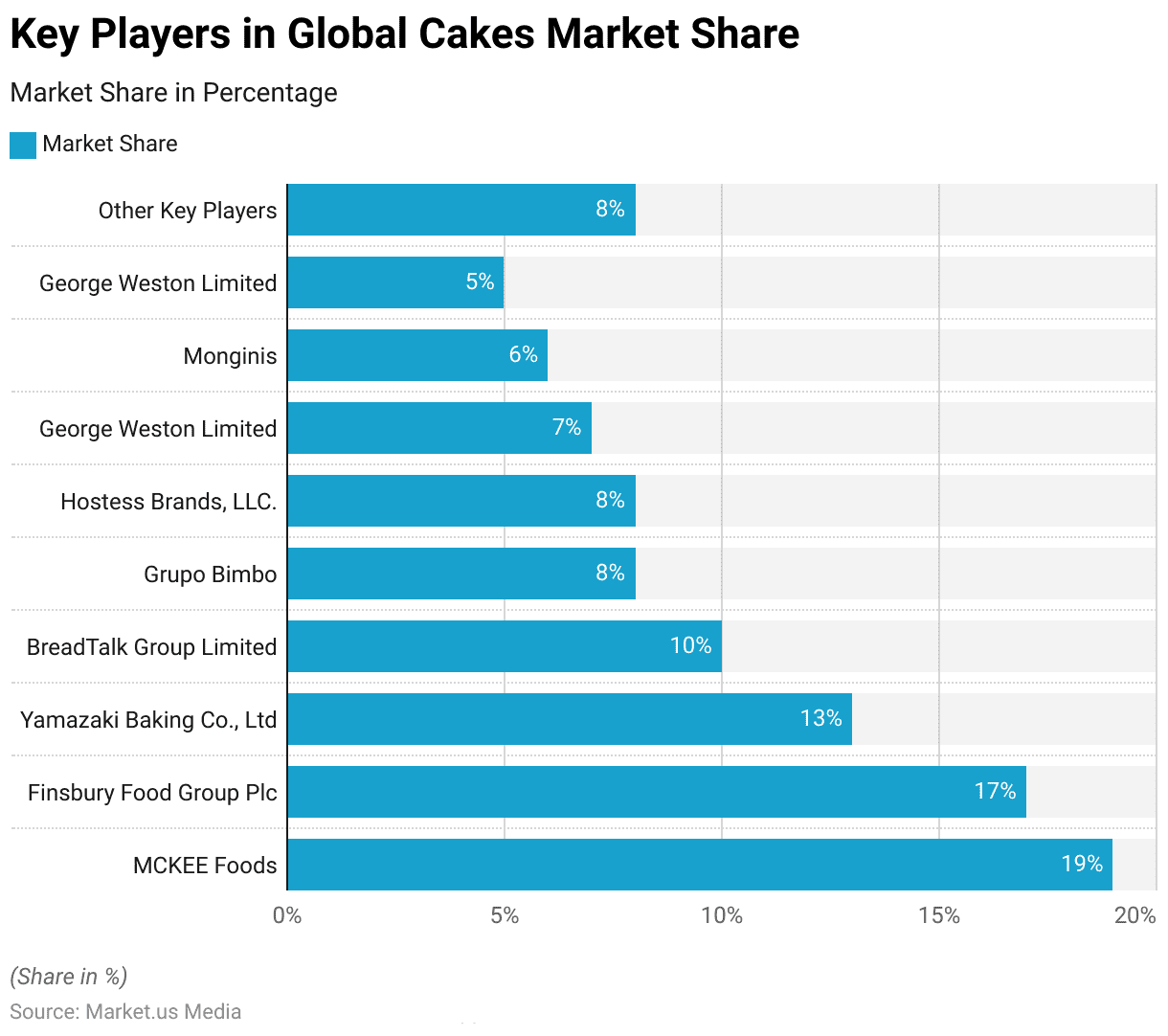
Consumer Preferences For Selecting Cakes Statistics
- Consumer preferences in the cake market remain centered on flavor as the primary factor influencing their purchase decisions.
- Given the indulgent nature of cake consumption, introducing new and enticing flavors inspired by popular culture. Like experimenting with unique combinations of flavors, and incorporating elements of luxury. Introducing contrasting textures can significantly stimulate impulse purchases and generate heightened interest in the category.
- Remarkably, a substantial 77% of consumers prioritize taste as the foremost consideration when selecting cakes, cake bars, or sweet baked goods, with price ranking as the second most influential factor.
- Additionally, an impressive 65% of consumers express a desire for more innovative and unconventional flavor options. Underscoring the potential for market growth through flavor-driven innovation.
- This underscores the importance for businesses in the cake industry to focus on flavor innovation to meet consumer expectations and capitalize on this lucrative aspect of the market.
(Food Manufacture UK)
Popular Ingredients and Flavors For Cakes Statistics
- The world of cakes is constantly evolving, and consumer preferences for ingredients and flavors are no exception.
- In this context, a survey reveals the popularity of various ingredients and flavors among cake enthusiasts.
- Scone-flavored cakes take the lead with a substantial 19.14% preference rate. Showcasing a penchant for the rich and crumbly texture reminiscent of scones.
- Cheesecake, known for its creamy and indulgent profile, closely follows at 15.86%. Indicating a strong affinity for the beloved dessert’s essence in cake form.
- Latte-flavored cakes, with their aromatic and coffee-infused notes, capture 13.12% of the consumer preference. Appealing to those who enjoy the combination of coffee and cake.
- Tea-infused cakes, at 10.26%, signify an emerging trend where the delicate flavors of various teas are being incorporated into cake recipes.
- Finally, the classic and ever-appealing berry flavor secures 8.12% of the preference. Offering a fruity and vibrant option for cake enthusiasts.
- These preferences shed light on the diverse and evolving landscape of cake flavors. Providing valuable insights for bakers and businesses looking to cater to the ever-changing tastes of consumers in the cake market.
(Source: Tastewise)
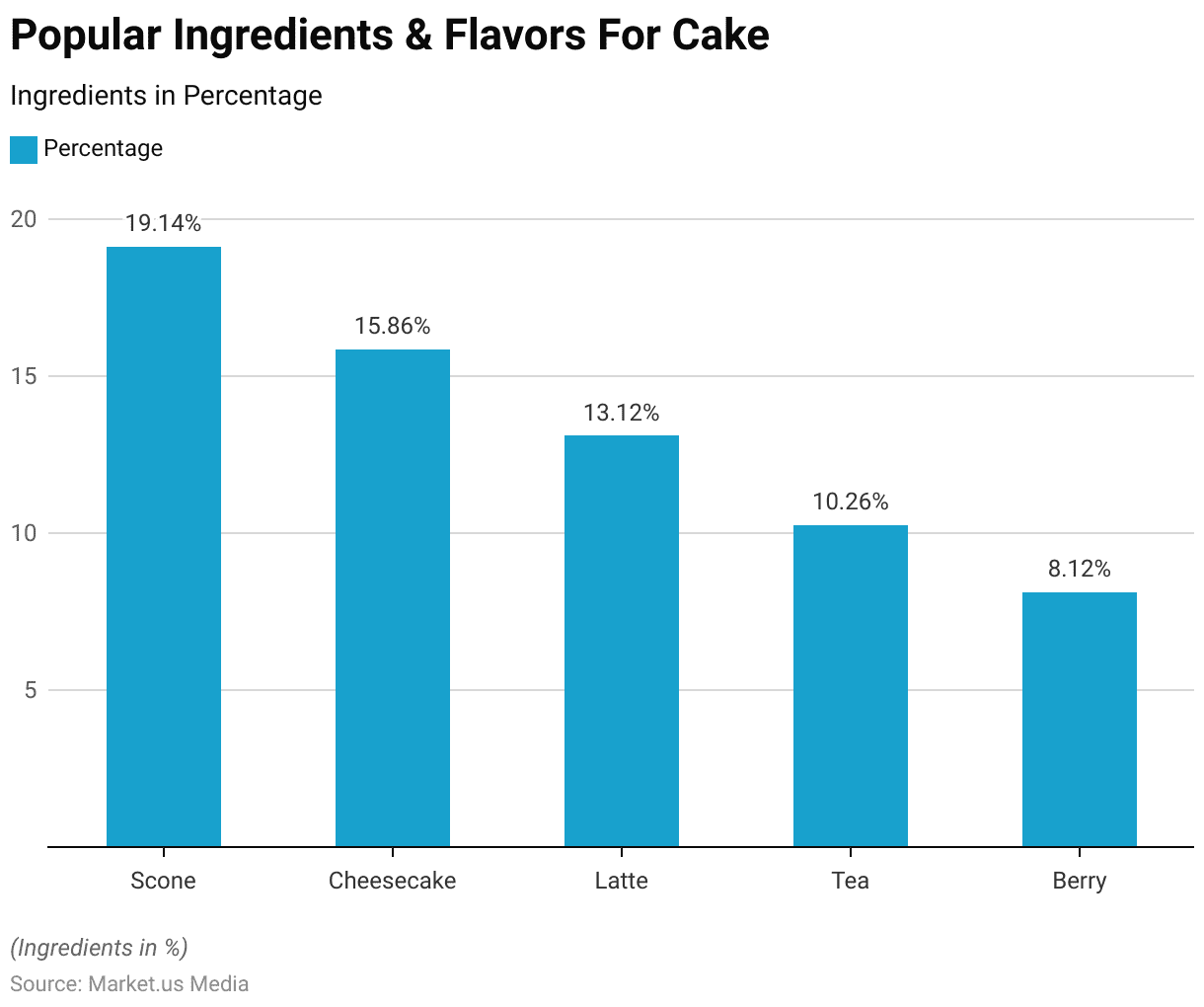
Demographics of Cakes Consumers Statistics
Cake Consumers Statistics According to Age
- Cake consumers span a wide range of age groups, and understanding their distribution is crucial for market analysis.
- Among these age groups, individuals aged 20 to 30 constitute the largest segment. Accounting for a significant 44.9% of cake consumers.
- This suggests that younger adults in their twenties are particularly enthusiastic about indulging in cakes, possibly due to their diverse and adventurous palates.
- Meanwhile, the age group of 31 to 40 makes up 11.6% of cake consumers. Indicating a smaller but notable presence in the market.
- The 41 to 50 age bracket represents 30.9% of consumers, showcasing a substantial portion of middle-aged individuals who appreciate cakes.
- Lastly, those aged above 51 contribute 20.6% to the consumer base, highlighting that even the older generation continues to enjoy cakes, emphasizing the timeless appeal of this sweet treat.
- These age-based insights underscore the importance of tailoring cake offerings to cater to the varied tastes and preferences of consumers across different age categories. Thereby optimizing market strategies and potential growth opportunities in the cake industry.
(Source: Economic and Technology Management Review)

According to Gender
- Cake consumption is not limited by gender, but there are noticeable variations in the preferences of consumers.
- Among cake enthusiasts, females dominate the consumer base, representing a majority share of 58.5%.
- This suggests that women tend to have a higher affinity for cakes, possibly due to their inclination towards sweet and indulgent treats.
- On the other hand, males contribute to 41.5% of cake consumers, indicating a significant presence in the market.
- This gender distribution underscores the importance of considering gender-specific preferences when crafting marketing strategies and product offerings within the cake industry.
- Recognizing and accommodating these preferences can lead to a more inclusive and effective approach to catering to a diverse consumer base.
(Source: Economic and Technology Management Review)
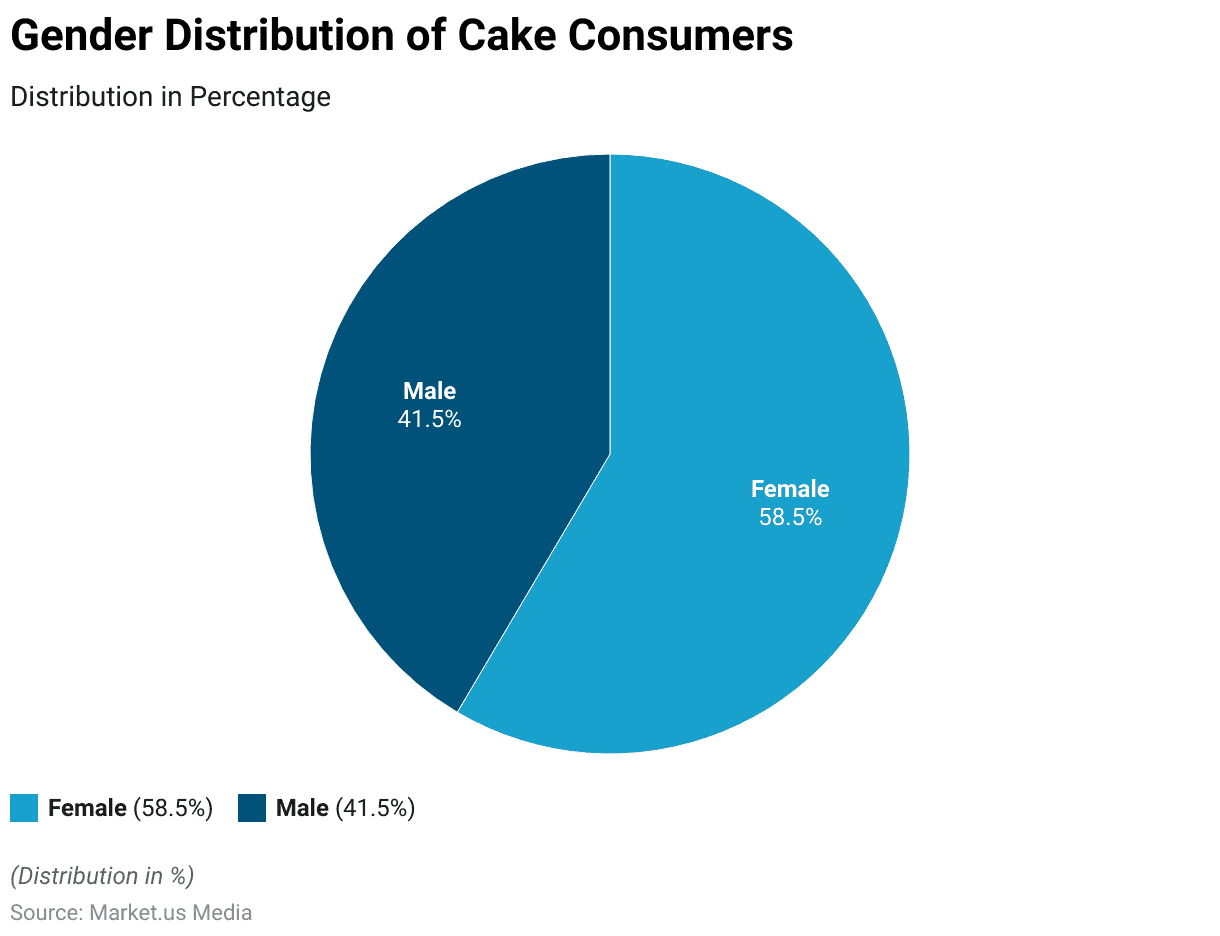
According to Education
- Cake consumers display varying educational backgrounds, shedding light on how different levels of education correlate with preferences for this indulgent dessert.
- The data reveals that individuals with a secondary education level constitute the largest segment, accounting for a significant majority at 53.6%.
- This suggests that those with a secondary education tend to form the core of cake consumers, possibly due to a combination of factors such as age and accessibility.
- Meanwhile, individuals with a university education level contribute significantly as well, representing 35.8% of the consumer base.
- This highlights the appeal of cakes to those with higher educational qualifications, possibly driven by their disposable income and exposure to diverse culinary experiences.
- In contrast, those with primary education levels make up a smaller 2.3% of consumers, while 8.3% fall into the “Others” category.
- These insights into education-based preferences emphasize the importance of segmenting and targeting cake offerings based on educational backgrounds to effectively cater to the diverse tastes and preferences within the consumer base, thereby optimizing market strategies in the cake industry.
(Source: Economic and Technology Management Review)
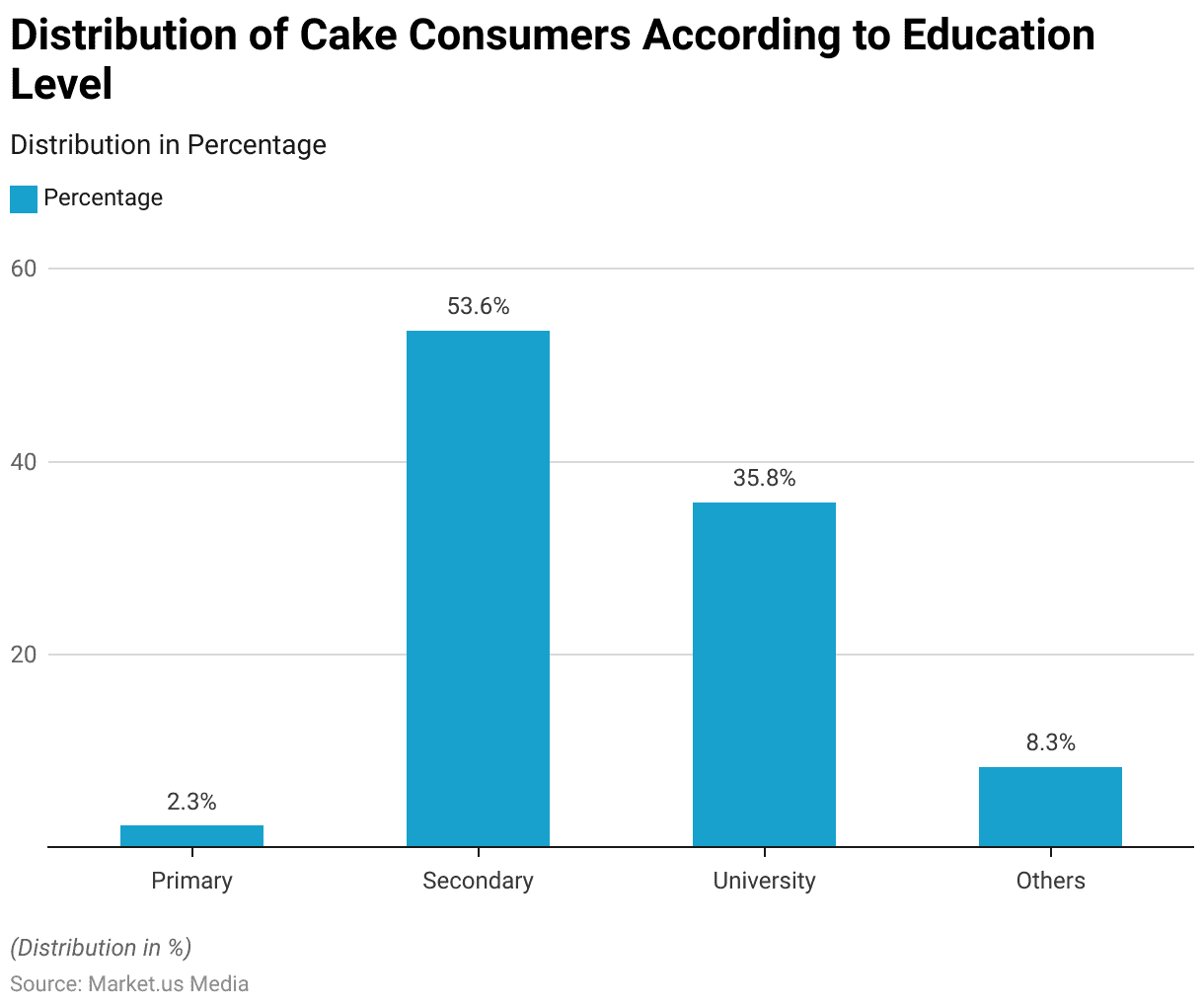
Recent Cakes Consumer Trends Statistics
- As inflation reaches historically high levels, consumers are increasingly seeking ways to economize on their food expenses.
- A significant 46% of respondents have indicated that they are reducing their purchases of breakfasts at restaurants, creating a noteworthy opportunity for expanding the range of breakfast items available in in-store bakeries.
- Although fresh bakery items are still more commonly associated with special occasions (67%) than everyday consumption (52%), there is a rising trend in spontaneous indulgence and comfort purchases.
- Notably, 31% of survey participants reported that they have increased their purchases of anytime treats in the past two years compared to the pre-pandemic period.
- Premium bakery products are primarily enjoyed in the comfort of one’s home, with 68% of respondents stating that they buy these items as treats for themselves and their families.
- Special celebrations (62%) and gatherings (42%) are also occasions where premium bakery products are commonly indulged in.
- When asked to define what makes a bakery purchase “premium,” respondents most frequently mentioned fresh fruit (46%), visible inclusions (42%), and unique flavors (42%).
- These insights highlight the shifting consumer behaviors and preferences in response to economic challenges and evolving lifestyle patterns, creating opportunities for bakeries to cater to these changing demands.
(Source: Baking Business)
Health Concerns Associated With Cakes Consumption Statistics
- In a research study involving nearly 1000 UK office workers, their attitudes and behaviors regarding workplace cake culture were explored.
- The findings revealed that cake was a common presence in the office, with 86% of respondents reporting its availability at least “once or twice a week.”
- Interestingly, 31% of participants attributed weight gain to office cake consumption, while 38% believed it made it challenging to maintain a healthy diet at work, and 59% felt it hindered their efforts to adhere to weight loss diets.
- This initial data seemed to favor the perspective that “office cake is detrimental.”
- However, another perspective emerged strongly. Surprisingly, 61% of respondents considered office cake to be a positive aspect, with 81% stating that it fosters camaraderie among colleagues, and 83% agreeing that it boosts people’s spirits.
- This viewpoint leaned towards the belief that “office cake is beneficial.”
- The most striking revelation was that when asked about their ideal frequency for office cake, a resounding 95% of participants expressed that they preferred it to be available once a week or even less frequently, with 41% suggesting a monthly occurrence.
- This data underscores the nuanced nature of office cake culture, with the majority advocating for moderation in its presence.
(Source: C3Health)
Recent Developments
New Product Launches:
- McKee Foods introduced Valentine’s Day-themed products including Vanilla Mini Donuts and Big Pack Valentine Cakes, expanding their seasonal offerings.
- Monginis Foods Private Limited updated its packaging to a more modern design while maintaining traditional elements.
- Catalina Crunch launched new Dark Chocolate Cookie Bars in Raspberry and Mint flavors, targeting the health-conscious segment with low-sugar and keto-friendly options.
- Elmhurst 1925 reintroduced its OatNog for the holiday season, catering to the demand for vegan and gluten-free products.
- Introduction of gourmet cake flavors inspired by international cuisines by bakery franchises in January 2024, offering unique and exotic cake options to customers.
- Launch of personalized cake decorating kits for home bakers by baking supply companies in March 2024, providing convenient tools and decorations for DIY cake projects.
Funding Rounds:
- Series B funding round for a cake delivery startup specializing in custom-designed cakes in February 2024, raising $30 million to expand delivery operations and invest in marketing initiatives.
- Seed funding for a cake mix company offering gluten-free and vegan options in April 2024, securing $8 million for product development and distribution expansion.
Mergers and Acquisitions:
- Cross-border collaborations are intensifying, with companies seeking growth beyond their domestic markets. This trend is driven by the need to diversify markets and access new talent pools, particularly in emerging markets like Asia and Africa.
- There is a growing focus on sustainable and impactful ventures. Companies are increasingly engaging in M&A that align with environmental stewardship and social responsibility, exploring sectors such as renewable energy and clean technology.
- In traditional industries like manufacturing, energy, and finance, there’s a consolidation trend where companies seek to achieve economies of scale and enhance market positions through strategic alliances.
- Acquisition of a popular bakery chain specializing in cakes by a leading food conglomerate in September 2023, expanding its presence in the dessert market.
- The merger between two artisanal cake bakeries in December 2023, combined their expertise in cake craftsmanship and flavor innovation.
Investment Landscape:
- Venture capital investments in cake startups totaled $2.5 billion in 2023. With a focus on companies offering innovative cake flavors, designs, and delivery services.
- Strategic partnerships and acquisitions between bakery chains, food retailers, and e-commerce platforms accounted for 55% of total investment activity in the cake market in 2023. Reflecting industry efforts to capitalize on consumer preferences for convenience and customization in cake purchasing.
Conclusion
Cakes Statistics – In summary, the cake industry is characterized by steady growth and evolving consumer preferences.
Flavor innovation is crucial, as taste and price heavily influence consumer choices. The workplace cake culture has both positive and negative aspects, highlighting the need for balance.
Understanding consumer demographics and maintaining product quality is essential for success in this dynamic market. Adaptation to changing consumer demands is key for long-term viability in the cake sector.
FAQs
Commonly favored cake flavors include chocolate, vanilla, red velvet, and lemon. However, preferences can vary by region and individual taste.
Popular cake decorating techniques include frosting with buttercream or fondant, using piping for intricate designs, and incorporating edible decorations like flowers, fondant figures, or sprinkles.
The primary difference is size and baking time. Cakes are larger and typically require longer baking times, while cupcakes are smaller and bake faster. Both share similar ingredients but may have variations in texture and flavor.
The tradition of birthday cakes dates back to ancient civilizations, where cakes were offered to gods during celebrations. Over time, it evolved into the practice of celebrating birthdays with a special cake, with candles symbolizing the person’s age.
For gluten-free cakes, you can use alternative flours like almond flour, coconut flour, or gluten-free all-purpose flour blends. Ensure other ingredients, like baking powder and flavorings, are also gluten-free.
Discuss your needs with our analyst
Please share your requirements with more details so our analyst can check if they can solve your problem(s)



